Material sources, impact and legal analysis
Create a subpage- Sylvain Bosquet
- /
- the 10-07-2018
- / 2588
The SB&WRC project is supported by the European program Interreg VA France (Channel) England and receives financial support from the ERDF.
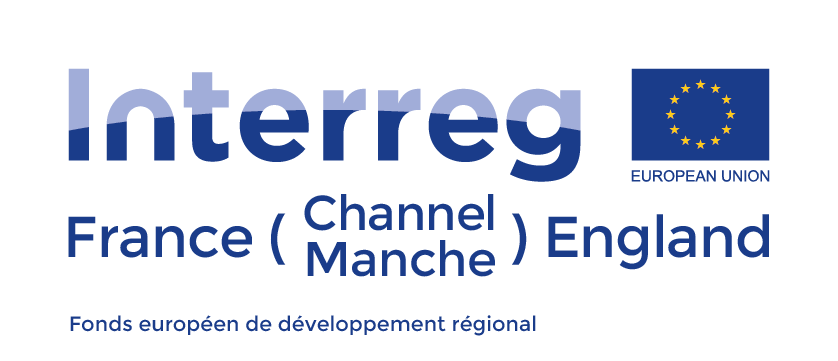
As part of the European Interreg France (Channel) England program, the SB&WRC project aims to create 3 prototypes of thermal insulation from bioresources and waste with a carbon footprint 25% lower than standard insulators on the market (rock wool and glass wool). The ambition of the project is to develop new insulation solutions to reduce building's carbon footprint and the mining of mineral resources, with real potential for medium-term development.
To enable the SB & WRC prototypes to achieve these objectives, their design is based on a phase of preliminary analyses targeting a series of technical and legal issues structuring across France France (Channel) England [FME]. Within this framework, and under the coordination of Nomadéis, the partners conducted four preliminary analyzes concerning in particular the technical and legal constraints of prototype production, their context of implementation in the built environment of the territory, and the evaluation modalities, their environmental and economic impact. The results of these preliminary analyzes will be exploited very soon during two design workshops bringing together project partners and sustainable building professionals (London - February 28, Rouen - March 13).
Back on a first semester of decisive project in the design of the SB & WRC prototypes:
- Reducing the mineral resource levy: what bioresources and waste sources?
- Integrating SB&WRC prototypes into existing buildings: what innovative option(s)?
- Mobilization of waste in the production of materials: what legal conditions?
- To objectify the environmental and economic impact of prototypes - which methodology to apply?
1. REDUCING COLLECTION OF NATURAL RESOURCES : WHAT BIORESOURCES AND WASTE SOURCES ?
Objectives
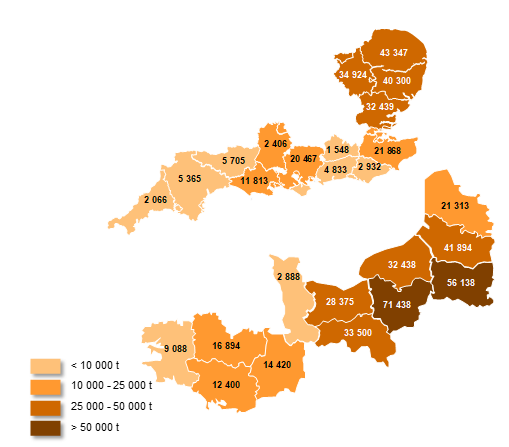 |
|
| Figure 1. Evaluation of the additional volume available of rapeseed straw |
In order to ensure the potential for large-scale development of the SB & WRC prototypes, the partners wanted to mobilize resources widely available in France (Channel) England. A first task was therefore to evaluate the available deposit of various pre-identified resources, and to study the main stocks and flows at the scale of the program area. The aim was to analyze in a precise manner the available volumes, the transport and treatment modalities and the structuring of the following raw material sectors:
- Agricultural co-products from wheat (straw), corn (canes) and oilseeds such as rapeseed and flax (grains and straw);
- Dedicated crop products: hemp fiber and linen;
- Terracotta waste and used textiles.
Methodological approach
Nomadéis has conducted, using the different fields of expertise of the partners, a qualitative and quantitative bibliographic analysis to measure theoretically available volumes and to formulate hypotheses on their current uses. Interviews with stakeholders in the agricultural sector and waste recovery sectors have clarified the approach and accurately determine the additional deposit available for construction.
First results
These analyzes made it possible to establish a first ranking of the resources according to their potential to be used as raw materials according to various criteria: their availability (current and future), in connection with the competition of use in particular, but also their accessibility (costs, technical difficulties of mobilization).
Resources satisfying all these criteria are rapeseed, flax, grain corn, cereal straw, terracotta and textiles. Hemp and textile flax, industrialized productions, remain more complex to mobilize.
2. INTEGRATING SB&WRC PROTOTYPES IN THE EXISTING BUILDING: WHAT INNOVATIVE OPTION(S)?
Objectives
In order to design prototypes specifically adapted to the particularities of the INTERREG FME zone, the partners wished to establish a typology of buildings allowing to identify the most widespread constructive systems on which the design of the prototypes could be based, facilitating in fact their subsequent massification.
Methodological approach
Nomadéis first drew up an overview of the Interreg France (Manche) England area (population count, analysis of population density at the scale of the two zones, identification of the main urban centers, analysis of the demographic evolution, etc.) in order to highlight the specificities of the area in terms of spatial organization and to analyze trends likely to have a long-term impact on building activity and thus the demand for building materials.
The project team then focused on establishing an inventory of the residential park at the scale of the Interreg France (Manche) England area, through the analysis of the structure of the housing stock and its recent evolution, and the typology of buildings (profile of dwellings, size of dwellings, energy performance, etc.).
Finally, an analysis of the recent dynamics of new construction across the Interreg France (Channel) England area was conducted.
First results
From this analysis appear several specificities to take into account to anticipate the future evolution of the demand for insulation materials (especially for renovation). In particular, the FME zone has a large proportion of relatively large single-family dwellings, mostly occupied by homeowners. Renovation of this building dating often before 1914 can also justify the use of bio-based materials, ideal to ensure the management of moisture transfer through walls built of local stone, rubble or stone, or terracotta full bricks, UK government pledging 300,000 new homes per annum. Regarding new construction, some signs of recovery in France as in England are observed. Building regulations are also favorable for the development of low-energy buildings.
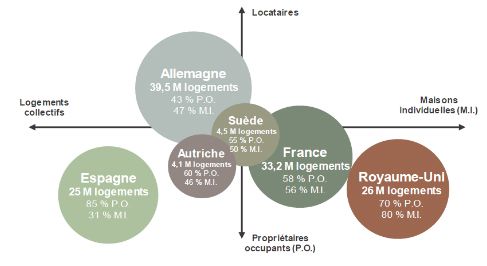
Figure 2. Comparison of the typology of housing stock across several European countries
3. INTEGRATING WASTE IN THE DESIGN OF MATERIALS: WHAT LEGAL CONDITIONS?
Objectives :
This activity aimed at clarifying the legal context governing waste treatment and recovery activities, so as to indicate, to any third party interested in the large-scale development of SB & WRC prototypes, the procedures to follow in order to comply with the applicable regulations.
Methodological approach
This work was based on a thorough bibliographic analysis. The challenge was to present both the general legal framework that regulates the use of recycled waste for the production of insulation in the building, but also the concrete obligations that result for manufacturers interested in this opportunity. Most of the studies consulted did not make it possible to understand what the tangible legal implications for actors in the field were. A long and painstaking research work was needed to gather the information that makes it possible to know these obligations for each stage of the production process.
Results :
The note was conceived as a teaching tool intended for actors wishing to substitute recycled waste for primary material in their production process. It incorporates an introductory diagram that allows the reader to locate and directly consult the parts of the note that concern him.
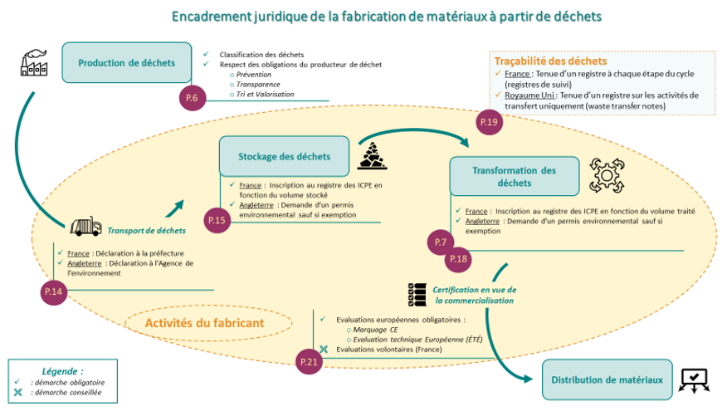
Figure 3: Synthetic diagram on the legal framework of the manufacture of materials from waste
In particular, it offers :
- A presentation of the key legal definitions, including the "waste" status, the obligations attached thereto, and the categorization of the actors involved in waste management;
- A summary of the regulatory issues to be taken into account for the recovery of waste, paying particular attention to the procedure for leaving the waste status;
- An inventory of the steps to follow at each step of the use of a waste to respect the law in force.
4. OBJECTING THE ENVIRONMENTAL AND ECONOMIC IMPACT OF PROTOTYPES - WHAT METHODOLOGY TO APPLY?
Objectives
In the first half of the year, the partners launched reflections on how to evaluate the economic and environmental impact of prototypes:
- How to measure the environmental benefits of the project and in particular the reduction of the carbon footprint?
- How to make sure of the economic profitability of these prototypes, for both producers (production costs) and consumers (purchase price and insulation performance, which affect energy consumption), compared to existing insulation materials?
Methodological approach
Nomadéis has conducted a benchmark of environmental and economic assessment methods that can be applied to prototypes of building materials and exchanged with the project partners to identify the expertise and tools available to each of them to contribute to this evaluation process.
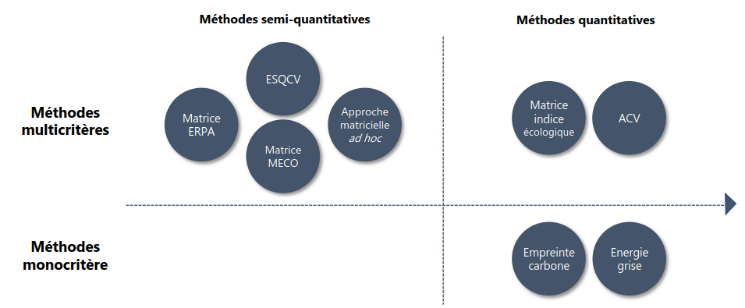
Figure 4: Comparison of Selected Environmental Assessment Methods
First results
In view of this analysis, the partners defined an evaluation methodology combining:
- A life cycle analysis, which is an integrated approach, based on international standards and therefore widely recognized. LCA is also the reference method for the production of FDES (Environmental and Sanitary Declaration Form) and EPD (Environmental Product Declarations), essential for communicating the environmental impact of a product;
- A biodegradability analysis, allowing to study in an experimental way the opportunities of return to the soil or composting of materials, in order to close the carbon loop of the materials in a logic of circular economy;
- An estimate of the cost price and the selling price, which will be compared to the thermal performance of the prototypes to ensure that consumers will have high-performance products at an affordable price.